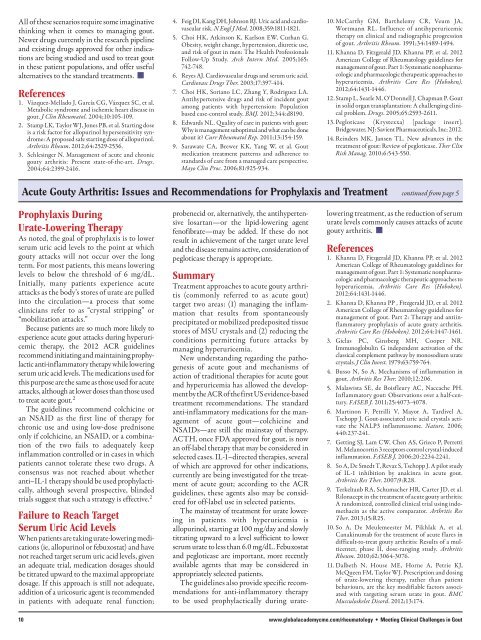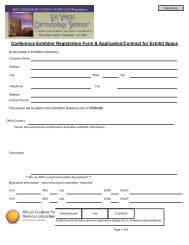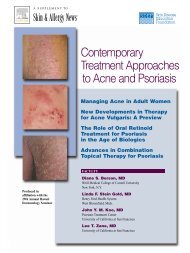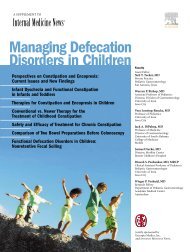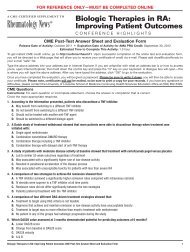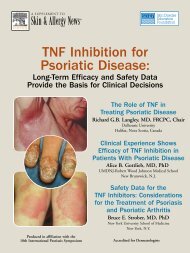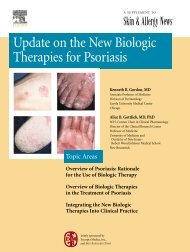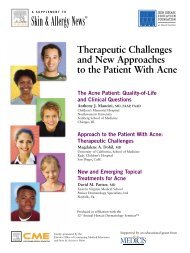Meeting Clinical Challenges in Gout - Global Academy for Medical ...
Meeting Clinical Challenges in Gout - Global Academy for Medical ...
Meeting Clinical Challenges in Gout - Global Academy for Medical ...
Create successful ePaper yourself
Turn your PDF publications into a flip-book with our unique Google optimized e-Paper software.
All of these scenarios require some imag<strong>in</strong>ativeth<strong>in</strong>k<strong>in</strong>g when it comes to manag<strong>in</strong>g gout.Newer drugs currently <strong>in</strong> the research pipel<strong>in</strong>eand exist<strong>in</strong>g drugs approved <strong>for</strong> other <strong>in</strong>dicationsare be<strong>in</strong>g studied and used to treat gout<strong>in</strong> these patient populations, and offer usefulalternatives to the standard treatments. •References1. Vázquez-Mellado J, García CG, Vázquez SC, et al.Metabolic syndrome and ischemic heart disease <strong>in</strong>gout. J Cl<strong>in</strong> Rheumatol. 2004;10:105-109.2. Stamp LK, Taylor WJ, Jones PB, et al. Start<strong>in</strong>g doseis a risk factor <strong>for</strong> allopur<strong>in</strong>ol hypersensitivity syndrome:A proposed safe start<strong>in</strong>g dose of allopur<strong>in</strong>ol.Arthritis Rheum. 2012;64:2529-2536.3. Schles<strong>in</strong>ger N. Management of acute and chronicgouty arthritis: Present state-of-the-art. Drugs.2004;64:2399-2416.4. Feig DI, Kang DH, Johnson RJ. Uric acid and cardiovascularrisk. N Engl J Med. 2008;359:1811-1821.5. Choi HK, Atk<strong>in</strong>son K, Karlson EW, Curhan G.Obesity, weight change, hypertension, diuretic use,and risk of gout <strong>in</strong> men: The Health ProfessionalsFollow-Up Study. Arch Intern Med. 2005;165:742-748.6. Reyes AJ. Cardiovascular drugs and serum uric acid.Cardiovasc Drugs Ther. 2003;17:397-414.7. Choi HK, Soriano LC, Zhang Y, Rodriguez LA.Antihypertensive drugs and risk of <strong>in</strong>cident goutamong patients with hypertension: Populationbased case-control study. BMJ. 2012;344:d8190.8. Edwards NL. Quality of care <strong>in</strong> patients with gout:Why is management suboptimal and what can be doneabout it? Curr Rheumatol Rep. 2011;13:154-159.9. Sarawate CA, Brewer KK, Yang W, et al. <strong>Gout</strong>medication treatment patterns and adherence tostandards of care from a managed care perspective.Mayo Cl<strong>in</strong> Proc. 2006;81:925-934.10. McCarthy GM, Barthelemy CR, Veum JA,Wortmann RL. Influence of antihyperuricemictherapy on cl<strong>in</strong>ical and radiographic progressionof gout. Arthritis Rheum. 1991;34:1489-1494.11. Khanna D, Fitzgerald JD, Khanna PP, et al. 2012American College of Rheumatology guidel<strong>in</strong>es <strong>for</strong>management of gout. Part 1: Systematic nonpharmacologicand pharmacologic therapeutic approaches tohyperuricemia. Arthritis Care Res (Hoboken).2012;64:1431-1446.12. Stamp L, Searle M, O’Donnell J, Chapman P. <strong>Gout</strong><strong>in</strong> solid organ transplantation: A challeng<strong>in</strong>g cl<strong>in</strong>icalproblem. Drugs. 2005;65:2593-2611.13. Pegloticase (Krystexxa) [package <strong>in</strong>sert].Bridgewater, NJ: Savient Pharmaceuticals, Inc; 2012.14. Re<strong>in</strong>ders MK, Jansen TL. New advances <strong>in</strong> thetreatment of gout: Review of pegloticase. Ther Cl<strong>in</strong>Risk Manag. 2010;6:543-550.Acute <strong>Gout</strong>y Arthritis: Issues and Recommendations <strong>for</strong> Prophylaxis and Treatment cont<strong>in</strong>ued from page 5Prophylaxis Dur<strong>in</strong>gUrate-Lower<strong>in</strong>g TherapyAs noted, the goal of prophylaxis is to lowerserum uric acid levels to the po<strong>in</strong>t at whichgouty attacks will not occur over the longterm. For most patients, this means lower<strong>in</strong>glevels to below the threshold of 6 mg/dL.Initially, many patients experience acuteattacks as the body’s stores of urate are pulled<strong>in</strong>to the circulation—a process that somecl<strong>in</strong>icians refer to as “crystal stripp<strong>in</strong>g” or“mobilization attacks.”Because patients are so much more likely toexperience acute gout attacks dur<strong>in</strong>g hyperuricemictherapy, the 2012 ACR guidel<strong>in</strong>esrecommend <strong>in</strong>itiat<strong>in</strong>g and ma<strong>in</strong>ta<strong>in</strong><strong>in</strong>g prophylacticanti-<strong>in</strong>flammatory therapy while lower<strong>in</strong>gserum uric acid levels. The medications used <strong>for</strong>this purpose are the same as those used <strong>for</strong> acuteattacks, although at lower doses than those usedto treat acute gout. 2The guidel<strong>in</strong>es recommend colchic<strong>in</strong>e oran NSAID as the first l<strong>in</strong>e of therapy <strong>for</strong>chronic use and us<strong>in</strong>g low-dose prednisoneonly if colchic<strong>in</strong>e, an NSAID, or a comb<strong>in</strong>ationof the two fails to adequately keep<strong>in</strong>flammation controlled or <strong>in</strong> cases <strong>in</strong> whichpatients cannot tolerate these two drugs. Aconsensus was not reached about whetheranti–IL-1 therapy should be used prophylactically,although several prospective, bl<strong>in</strong>dedtrials suggest that such a strategy is effective. 2Failure to Reach TargetSerum Uric Acid LevelsWhen patients are tak<strong>in</strong>g urate-lower<strong>in</strong>g medications(ie, allopur<strong>in</strong>ol or febuxostat) and havenot reached target serum uric acid levels, givenan adequate trial, medication dosages shouldbe titrated upward to the maximal appropriatedosage. If this approach is still not adequate,addition of a uricosuric agent is recommended<strong>in</strong> patients with adequate renal function;probenecid or, alternatively, the antihypertensivelosartan—or the lipid-lower<strong>in</strong>g agentfenofibrate—may be added. If these do notresult <strong>in</strong> achievement of the target urate leveland the disease rema<strong>in</strong>s active, consideration ofpegloticase therapy is appropriate.SummaryTreatment approaches to acute gouty arthritis(commonly referred to as acute gout)target two areas: (1) manag<strong>in</strong>g the <strong>in</strong>flammationthat results from spontaneouslyprecipitated or mobilized predeposited tissuestores of MSU crystals and (2) reduc<strong>in</strong>g theconditions permitt<strong>in</strong>g future attacks bymanag<strong>in</strong>g hyperuricemia.New understand<strong>in</strong>g regard<strong>in</strong>g the pathogenesisof acute gout and mechanisms ofaction of traditional therapies <strong>for</strong> acute goutand hyperuricemia has allowed the developmentby the ACR of the first US evidence-basedtreatment recommendations. The standardanti-<strong>in</strong>flammatory medications <strong>for</strong> the managementof acute gout—colchic<strong>in</strong>e andNSAIDs—are still the ma<strong>in</strong>stay of therapy.ACTH, once FDA approved <strong>for</strong> gout, is nowan off-label therapy that may be considered <strong>in</strong>selected cases. IL-1–directed therapies, severalof which are approved <strong>for</strong> other <strong>in</strong>dications,currently are be<strong>in</strong>g <strong>in</strong>vestigated <strong>for</strong> the treatmentof acute gout; accord<strong>in</strong>g to the ACRguidel<strong>in</strong>es, these agents also may be considered<strong>for</strong> off-label use <strong>in</strong> selected patients.The ma<strong>in</strong>stay of treatment <strong>for</strong> urate lower<strong>in</strong>g<strong>in</strong> patients with hyperuricemia isallopur<strong>in</strong>ol, start<strong>in</strong>g at 100 mg/day and slowlytitrat<strong>in</strong>g upward to a level sufficient to lowerserum urate to less than 6.0 mg/dL. Febuxostatand pegloticase are important, more recentlyavailable agents that may be considered <strong>in</strong>appropriately selected patients.The guidel<strong>in</strong>es also provide specific recommendations<strong>for</strong> anti-<strong>in</strong>flammatory therapyto be used prophylactically dur<strong>in</strong>g urate-lower<strong>in</strong>g treatment, as the reduction of serumurate levels commonly causes attacks of acutegouty arthritis. •References1. Khanna D, Fitzgerald JD, Khanna PP, et al. 2012American College of Rheumatology guidel<strong>in</strong>es <strong>for</strong>management of gout. Part 1: Systematic nonpharmacologicand pharmacologic therapeutic approaches tohyperuricemia. Arthritis Care Res (Hoboken).2012;64:1431-1446.2. Khanna D, Khanna PP , Fitzgerald JD, et al. 2012American College of Rheumatology guidel<strong>in</strong>es <strong>for</strong>management of gout. Part 2: Therapy and anti<strong>in</strong>flammatoryprophylaxis of acute gouty arthritis.Arthritis Care Res (Hoboken). 2012;64:1447-1461.3. Giclas PC, G<strong>in</strong>sberg MH, Cooper NR.Immunoglobul<strong>in</strong> G <strong>in</strong>dependent activation of theclassical complement pathway by monosodium uratecrystals. J Cl<strong>in</strong> Invest. 1979;63:759-764.4. Busso N, So A. Mechanisms of <strong>in</strong>flammation <strong>in</strong>gout. Arthritis Res Ther. 2010;12:206.5. Malawista SE, de Boisfleury AC, Naccache PH.Inflammatory gout: Observations over a half-century.FASEB J. 2011;25:4073-4078.6. Mart<strong>in</strong>on F, Petrilli V, Mayor A, Tardivel A,Tschopp J. <strong>Gout</strong>-associated uric acid crystals activatethe NALP3 <strong>in</strong>flammasome. Nature. 2006;440:237-241.7. Gett<strong>in</strong>g SJ, Lam CW, Chen AS, Grieco P, PerrettiM. Melanocort<strong>in</strong> 3 receptors control crystal-<strong>in</strong>duced<strong>in</strong>flammation. FASEB J. 2006;20:2234-2241.8. So A, De Smedt T, Revaz S, Tschopp J. A pilot studyof IL-1 <strong>in</strong>hibition by anak<strong>in</strong>ra <strong>in</strong> acute gout.Arthritis Res Ther. 2007;9:R28.9. Terkeltaub RA, Schumacher HR, Carter JD, et al.Rilonacept <strong>in</strong> the treatment of acute gouty arthritis:A randomized, controlled cl<strong>in</strong>ical trial us<strong>in</strong>g <strong>in</strong>domethac<strong>in</strong>as the active comparator. Arthritis ResTher. 2013;15:R25.10. So A, De Meulemeester M, Pikhlak A, et al.Canak<strong>in</strong>umab <strong>for</strong> the treatment of acute flares <strong>in</strong>difficult-to-treat gouty arthritis: Results of a multicenter,phase II, dose-rang<strong>in</strong>g study. ArthritisRheum. 2010;62:3064-3076.11. Dalbeth N, House ME, Horne A, Petrie KJ,McQueen FM, Taylor WJ. Prescription and dos<strong>in</strong>gof urate-lower<strong>in</strong>g therapy, rather than patientbehaviours, are the key modifiable factors associatedwith target<strong>in</strong>g serum urate <strong>in</strong> gout. BMCMusculoskelet Disord. 2012;13:174.10 www.globalacademycme.com/rheumatology • <strong>Meet<strong>in</strong>g</strong> <strong>Cl<strong>in</strong>ical</strong> <strong>Challenges</strong> <strong>in</strong> <strong>Gout</strong>


